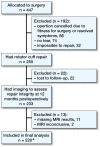Increasing age and tear size reduce rotator cuff repair healing rate at 1 year
- PMID: 28880113
- PMCID: PMC5694804
- DOI: 10.1080/17453674.2017.1370844
Increasing age and tear size reduce rotator cuff repair healing rate at 1 year
Abstract
Background and purpose - There is a need to understand the reasons why a high proportion of rotator cuff repairs fail to heal. Using data from a large randomized clinical trial, we evaluated age and tear size as risk factors for failure of rotator cuff repair. Patients and methods - Between 2007 and 2014, 65 surgeons from 47 hospitals in the National Health Service (NHS) recruited 447 patients with atraumatic rotator cuff tendon tears to the United Kingdom Rotator Cuff Trial (UKUFF) and 256 underwent rotator cuff repair. Cuff integrity was assessed by imaging in 217 patients, at 12 months post-operation. Logistic regression analysis was used to determine the influence of age and intra-operative tear size on healing. Hand dominance, sex, and previous steroid injections were controlled for. Results - The overall healing rate was 122/217 (56%) at 12 months. Healing rate decreased with increasing tear size (small tears 66%, medium tears 68%, large tears 47%, and massive tears 27% healed). The mean age of patients with a healed repair was 61 years compared with 64 years for those with a non-healed repair. Mean age increased with larger tear sizes (small tears 59 years, medium tears 62 years, large tears 64 years, and massive tears 66 years). Increasing age was an independent factor that negatively influenced healing, even after controlling for tear size. Only massive tears were an independent predictor of non-healing, after controlling for age. Interpretation - Although increasing age and larger tear size are both risks for failure of rotator cuff repair healing, age is the dominant risk factor.
Figures
References
-
- Ahmad S, Haber M Bokor D J.. The influence of intraoperative factors and postoperative rehabilitation compliance on the integrity of the rotator cuff after arthroscopic repair. J Shoulder Elbow Surg 2015, 24 (2): 229–35. - PubMed
-
- Antuña S, Barco R, Martínez Díez J M, Sánchez Márquez J M.. Platelet-rich fibrin in arthroscopic repair of massive rotator cuff tears: A prospective randomized pilot clinical trial. Acta Orthop Belg 2013; 79 (1): 25–30. - PubMed
-
- Arndt J, Clavert P, Mielcarek P, Bouchaib J, Meyer N, Kempf J F, French Society for S Elbow . Immediate passive motion versus immobilization after endoscopic supraspinatus tendon repair: A prospective randomized study. Orthop Traumatol Surg Res 2012; 98(6Suppl): S131–S8. - PubMed
-
- Barber F A, Burns J P, Deutsch A, Labbe M R, Litchfield R B.. A prospective randomized evaluation of acellular human dermal matrix augmentation for arthroscopic rotator cuff repair. Arthroscopy 2012; 28 (1): 8–15. - PubMed
-
- Boyer P, Bouthors C, Delcourt T, Stewart O, Hamida F, Mylle G, Massin P.. Arthroscopic double-row cuff repair with suture-bridging: A structural and functional comparison of two techniques. Knee Surg Sports Traumatol Arthrosc 2015; 23 (2): 478–86. - PubMed
Publication types
MeSH terms
Grants and funding
LinkOut - more resources
Full Text Sources
Other Literature Sources
Medical

